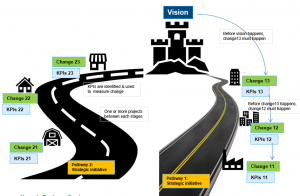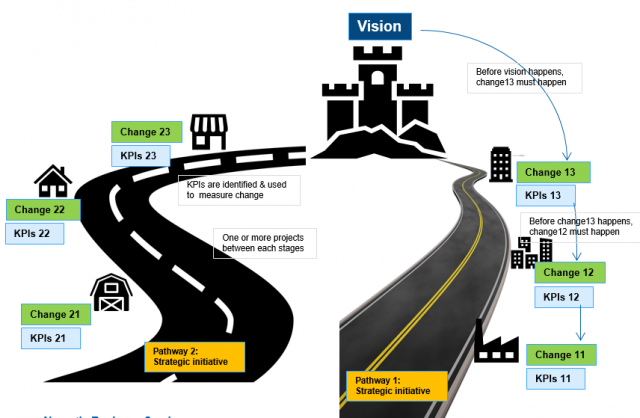
Have you ever wanted to design a solution for an issue but weren’t sure how to do it? One theory that can help is the theory of change. The theory of change provides a framework for designing solutions by focusing on the steps needed to achieve desired outcomes or results. It also helps identify what needs to happen in order for the solution to be implemented successfully and realizing the desired outcomes. The theory of change when combined with data-driven decision making can result in great impact. In order to design solutions that have an impact and are sustainable, it is important to understand the theory of change as well as how data-driven decision-making can be used when creating those solutions. In this post, we break down the theory of change and how it can be used when designing solutions!
What is the theory of change?
Theory of change is defined as “a theory that describes how a proposed solution to an issue will bring about the desired results“. It allows you to take take strategic approach to solution design rather than tactical approach. The theory of change may be utilized in a number of situations, such as when there is a desire to achieve an outcome that will not happen on its own and therefore requires some type of intervention. When you are designing a solution, the theory of change can help ensure that all aspects of an issue or problem are considered when implementing different solutions. It may be difficult for organizations and/or individuals to solve a problem or address an issue on their own, but the theory of change allows for the transformation from theory into action. The theory of change can provide a great deal of structure and direction when designing solutions but it is important to remember that this theory does not have all the answers- there may still be unforeseen events or problems along the way that will require additional changes or adjustments!
The picture below represents the concept of theory of change:

In the theory of change, there are four steps involved:
- Identify the vision/problem and desired outcome(s) to be addressed by a proposed solution. This involves identifying stakeholders and key actors who will be impacted by this issue or affected by the implementation of a certain action/solution. It also involves careful planning around what the desired results of this solution would be.
- Identify the changes that need to happen and how they will result in the desired outcome. There should be an emphasis on both short-term and long-term changes that can occur through this theory but also taking into account any unforeseen events/problems that may need to be addressed. Group the changes into the pathway of changes. These pathways can be labeled as strategic changes.
- Determine the theory’s assumptions and logic in order to create a logical framework based on general principles or existing theory that will explain how your proposed solution will bring about the desired outcome(s).
- Identify what needs to happen in form of projects, which is broken down into inputs, activities, and outputs. This involves identifying and mapping out all of the actions, events, or circumstances that need to happen in relation to every change. This includes understanding who needs to do what, when they need to complete it, and where the resources are needed in order for this theory to be successful. The set of activities can be grouped within one or more projects.
- Assess whether your theory is feasible or not, considering feasibility across time (long-term), geographic space (local/regional), and political barriers (national). Take into consideration any potential obstacles that may arise.
- Identify KPIs: The theory of the change process must include how success will be measured using different KPIs. Different measures are used depending on what theory you are describing. Measures for individual behavior may be different from the theory of change for an organization.
- Communicate the solution design based on the theory of change: Finally, communicate your theory to others using clear language. This will help them understand how your solution will bring about the desired outcome(s).
- Execute the projects: Execute projects along different pathways of change.
- Assess and monitor progress while executing projects outputs towards achieving desired outcomes and adapting as needed throughout implementation. This involves monitoring how well this theory is working overtime through an iterative process (i.e., steps or events that need to take place may not occur, maybe occurring faster or slower than anticipated, and therefore will need to be adjusted). This part of the theory also involves assessing whether there are additional changes that should occur as a result.
- Evaluate results through systematic data collection and analysis. This process is emphasized throughout each step but particularly at this point in time where it is important to understand what the theory of change has led to. This involves gathering data about what is occurring- where are there gaps in theory? What other actions may need to take place as a result?
- Measure the outcomes and impact of the theory of change. This is where the theory is evaluated against what actually happened- did this theory work? Why or why not? If it didn’t, how can changes be made to make sure that success does occur next time around by having different results/outcomes from a new theory of change?
- Identify lessons learned and adjust accordingly
What are some examples of theory of change?
The theory of change can be used to help organizations and practitioners design their proposed solution to an issue or problem by identifying what needs to happen in order for the desired results/outcomes to occur.
Here are few examples of how the theory of change can be used effectively:
- Food security issue: The Mexican government made a theory of change to address the issue of food security. The theory focused on how a proposed solution would bring about the desired outcome which was reducing poverty and increasing access to quality nutrition, specifically for the youth population in Mexico by 2020. In order to achieve this goal, there needed to be specific inputs such as funding from government agencies or organizations, activities such as increasing the number of farmers or individuals who are trained in sustainable agricultural methods, and outputs which included increased production of food by these farmers.
- Children’s poverty: Theory of change was used to address the issue of poverty among children living in rural areas. The theory focused on how a solution would bring about the desired outcome which was improving access to quality education for these children. In order to achieve this goal, there needed to be specific inputs such as increased funding and/or training of teachers or other school staff, activities that would increase the number of students who attend schools and stay in school (such as scholarships), outputs which included improved learning outcomes among students.
- Child malnutrition: The theory of change was used by the government of Malawi to address the issue of child malnutrition. The theory focused on how a solution would bring about the desired outcome which was reducing the under-five mortality rate by 50% and improved nutrition among children aged 0-60 months, specifically for those who are less than two years old by 2020. In order to achieve this goal, there needed to be specific inputs such as increased funding for nutrition programs and/or initiatives, activities that would increase the number of children who are breastfed within one hour after birth or exclusively breastfed until six months old (which reduces malnutrition), and outputs which included improved health outcomes.
- Climate change: The theory of change can be used to address climate change. The theory focuses on how a solution would bring about the desired outcome which was reducing greenhouse gas emissions by 80% in 2050 compared to 1990 levels. In order for this theory to have any chance at being successful, there are specific inputs such as increased funding and/or technological advancements when it comes to renewable energy sources, activities that would reduce carbon emissions by increasing the use of alternative fuel vehicles or promoting public transportation usage, outputs which included reduced greenhouse gas emissions.
- Poverty issues: The theory of change can be used to address poverty issues in developing countries. The theory focuses on how a solution will bring about the desired outcome which is reducing extreme poverty rates among people living in developing countries by 50% globally and ending poverty for good. In order to achieve this goal, there need to be specific inputs such as increased funding from organizations or governments, activities that would increase the number of people who have access to financial services (such as banks), outputs which included reduced extreme poverty rates worldwide.
- Poverty issues: The theory of change was used during the United Nation’s Millenium Project (2000) where it identified how poverty issues can be reduced by 50% globally and ended poverty for good, which will require specific inputs such as increased funding from organizations or governments, activities that would increase the number of people who have access to financial services (such as banks), and outputs which included reduced extreme poverty rates worldwide.
- Coefficient of Variation in Regression Modelling: Example - November 9, 2025
- Chunking Strategies for RAG with Examples - November 2, 2025
- RAG Pipeline: 6 Steps for Creating Naive RAG App - November 1, 2025
I found it very helpful. However the differences are not too understandable for me